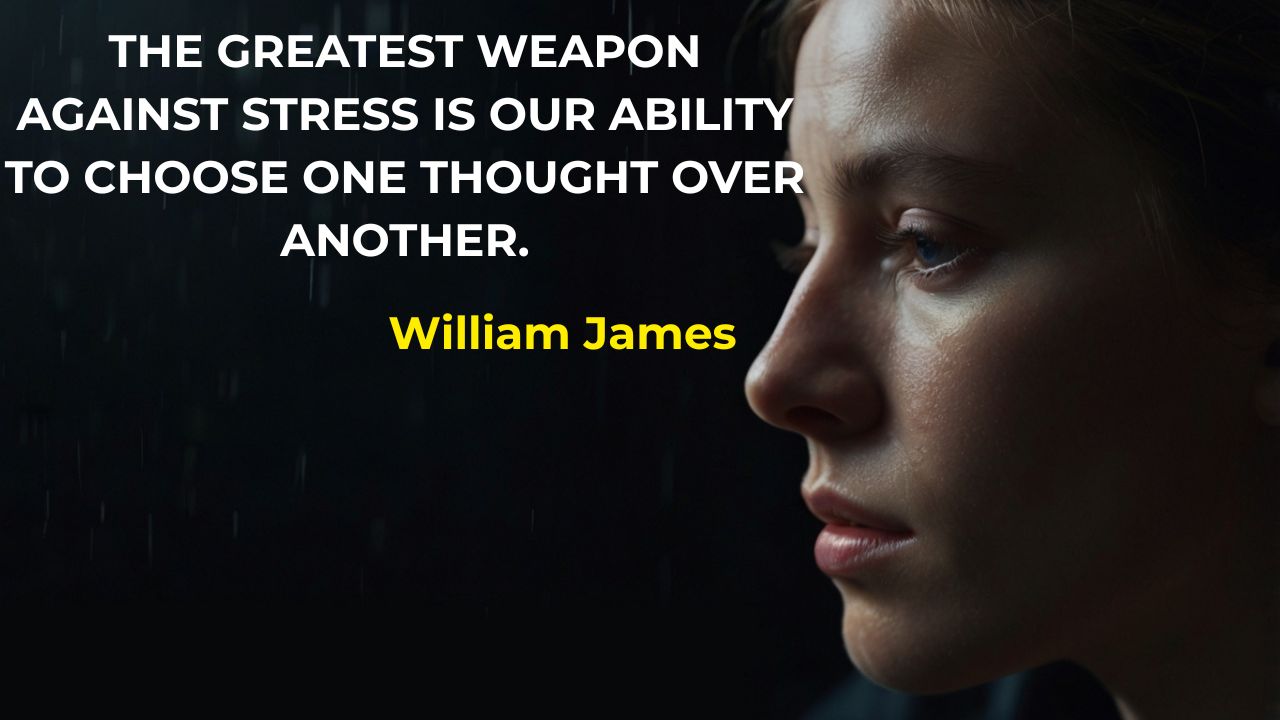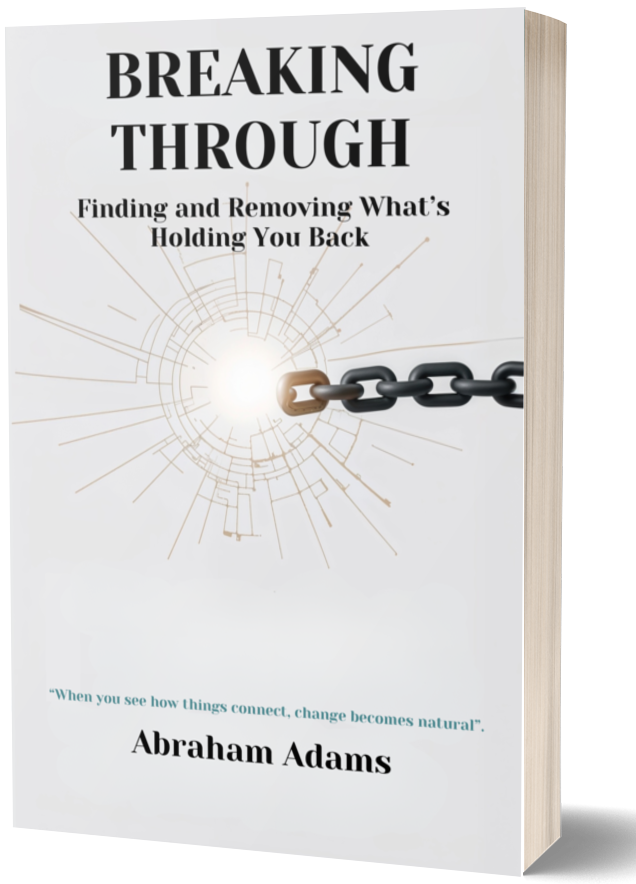Super User
Why Your Solutions Keep Backfiring
Why Your Solutions Keep Backfiring
The hidden reason your best efforts make problems worse
Imagine you're in a tug-of-war contest, pulling as hard as you can against the opposing team. Suddenly, you get a brilliant idea: "If I pull even harder, we'll definitely win!"
So you dig in your heels, grip the rope tighter, and pull with everything you've got. But something strange happens - the harder you pull, the harder the other team pulls back. Your increased effort doesn't just fail to win the game; it makes the whole struggle more intense and exhausting for everyone involved.
Now imagine that the "opposing team" isn't other people - it's your own life pushing back against your efforts to change it.
Welcome to the most frustrating truth about personal change: the harder you fight against certain problems, the stronger they become.
The Boomerang That Always Returns
Meet Tom, a perfectionist who's tired of being stressed about every little detail. He decides to force himself to relax. He makes rules: "Don't check your work more than twice," "Don't worry about things you can't control," "Just let go and be more easygoing."
But here's what happens: Every time Tom tries to force himself to relax, he becomes tense about whether he's relaxing correctly. He starts checking to see if he's being perfectionist about not being perfectionist. He worries about whether he's successfully not worrying.
His solution - trying harder to be less of a perfectionist - has made him more perfectionist than ever. The rope is pulling back.
The Thermostat in Your Head
Your life operates like a thermostat system. When a room gets too cold, the heater kicks in. When it gets too hot, the air conditioning turns on. The system automatically corrects any deviation from the set temperature.
You have psychological thermostats too - invisible settings that determine your "normal" levels of:
- How much stress you can handle before you automatically create relief
- How much success you're comfortable with before you unconsciously sabotage yourself
- How close you can get to people before you automatically create distance
- How much money you believe you deserve before you find ways to spend or lose it
- How much happiness you can experience before you start expecting something bad to happen
When you try to change too quickly or dramatically, your internal thermostat kicks in to bring you back to your familiar set point. It doesn't matter if your familiar level is actually making you miserable - your nervous system treats "familiar" as "safe."
The Rubber Band Effect
Think of your comfort zone as a giant rubber band. You can stretch it pretty far in any direction, but it takes constant effort. The further you stretch it, the more force it exerts to snap you back to your original shape.
Most people approach change by trying to stretch their rubber band as far as possible as fast as possible. They go on extreme diets, completely overhaul their schedule, or try to transform their personality overnight.
This creates maximum resistance. The rubber band pulls back with tremendous force, usually snapping them back past their starting point. They end up heavier than when they started the diet, more disorganized than before they tried the new system, or more stuck in old patterns than before they attempted to change.
The Ecosystem That Fights Back
Your habits don't exist in isolation - they're part of an ecosystem. Every habit supports other habits, and they all work together to keep your life stable and predictable.
When you try to change one habit without understanding its role in the ecosystem, the other habits fight to preserve the status quo.
Sarah decides to wake up earlier to exercise. Sounds simple, right? But her new wake-up time disrupts her entire ecosystem:
- She's tired earlier in the evening, which means she doesn't spend as much time with her partner
- Her partner feels neglected and starts conflicts that stress Sarah out
- When Sarah is stressed, she craves comfort food and skips workouts
- Skipping workouts makes her feel guilty, which creates more stress
- The stress makes her stay up later scrolling her phone to decompress
- Staying up later makes waking up early impossible
Sarah thinks she has a willpower problem. Actually, she has an ecosystem problem. Her morning exercise habit threatened the stability of her relationship ecosystem, so the ecosystem activated immune responses to eliminate the threat.
Pushing-the-River Problem
There's an old saying: "You can't push the river." Water flows around obstacles, not through them. The harder you push against a river, the more turbulence you create, but the river keeps flowing in the same direction.
Your life patterns are like a river - they have tremendous momentum and flow around obstacles naturally. When you try to force them to change direction by applying direct pressure, you create turbulence and exhaustion, but the underlying current remains the same.
Mark hates his job and decides to force himself to have a better attitude. Every morning, he gives himself pep talks, tries to focus on the positive aspects, and pushes down his negative feelings.
But emotions are like water - they flow around the obstacles you put in their way. Mark's suppressed frustration doesn't disappear; it seeps out in other forms. He becomes irritable with his family, develops mysterious physical symptoms, and finds himself procrastinating more at work.
His forced positive attitude creates a dam that makes everything downstream more turbulent. He's not changing the river; he's just creating a backup that floods other areas of his life.
The Hidden Feedback Loop
Here's the key insight: most problems exist because they're solving another problem you can't see.
Your procrastination might be protecting you from the fear of failure. Your people-pleasing might be protecting you from the fear of rejection. Your worrying might be protecting you from the fear of being caught off-guard. Your overspending might be protecting you from the fear of feeling deprived.
When you attack the symptom directly - trying to force yourself to stop procrastinating, people-pleasing, worrying, or overspending - you're threatening the protection system. So the system fights back by making the symptom stronger.
It's like trying to get rid of a bodyguard without addressing the threat they're protecting you from. The bodyguard isn't going to leave just because you ask nicely. They're going to work harder to keep you safe.
The Hydra Phenomenon
In Greek mythology, the Hydra was a monster that grew two heads every time someone cut one off. The more heroes fought it, the stronger it became.
Many life problems work the same way. Attack them directly, and they multiply:
Try to control your teenager's behavior through stricter rules → They rebel more creatively → You create stricter rules → They rebel more intensely
Try to fix your marriage by pointing out all the problems → Your partner becomes defensive → You point out more problems → Your partner withdraws further
Try to lose weight by severely restricting calories → Your metabolism slows down → You restrict more → Your body hoards fat more efficiently
Try to reduce anxiety by avoiding anxiety-provoking situations → Your world gets smaller → You become more anxious about normal things → You avoid more situations
Each "solution" feeds the problem, making it stronger and more entrenched.
The Aikido Approach
Aikido is a martial art based on redirecting force rather than opposing it. When someone pushes you, instead of pushing back, you step aside and use their momentum to throw them off balance.
The same principle applies to life problems. Instead of fighting against unwanted patterns, you learn to work with the energy that's creating them.
Instead of forcing yourself to stop procrastinating, you get curious about what you're avoiding and address the underlying fear.
Instead of trying to control your partner's behavior, you change your own responses and let the relationship dynamic shift naturally.
Instead of fighting your anxiety directly, you examine what your anxiety is trying to protect you from and find better ways to feel safe.
The Patience Paradox
Here's the paradox: the fastest way to change is often to slow down. The most effective force is often the gentlest pressure. The strongest position is often to stop pushing altogether.
When you stop fighting the river and start working with its current, you can guide it gradually toward a new course. When you stop stretching the rubber band to its breaking point and instead expand it gradually, it eventually takes a new shape without snapping back.
When you stop triggering your internal thermostat by making dramatic changes and instead adjust the temperature slowly, your system learns to be comfortable at a new set point.
The Questions That Change Everything
The next time you find yourself frustrated because your solution isn't working, ask these questions:
"What if this problem is protecting me from something worse?"
"What if my 'solution' is actually feeding the problem?"
"What would happen if I stopped pushing against this and started working with it?"
"What wants to change naturally, and how can I support that instead of forcing it?"
The Invitation to Surrender
This isn't about giving up or accepting problems you don't want. It's about recognizing that force often creates counter-force, and that there might be a more elegant way to create the changes you're seeking.
The problems that feel most stuck are often the ones where you're unknowingly fighting against yourself. The solutions that work best are often the ones that feel like cooperation rather than combat.
Sometimes the most powerful thing you can do is stop doing what isn't working and create space for something new to emerge.
In our next article, we'll explore how to find the one small change that can transform multiple areas of your life simultaneously - the place where minimum effort creates maximum results.
The Invisible Forces Running Your Life
The Invisible Forces Running Your Life
Why smart people keep making the same mistakes over and over
Picture this: You're driving down a straight, empty highway when suddenly your car starts veering to the right. You grip the steering wheel tighter and force it back to the left. For a moment, you're driving straight again.
But then it happens again. The car drifts right. You correct it. It drifts right again. You correct it again. Mile after mile, you're fighting the steering wheel, wondering why you can't seem to drive straight.
Any mechanic would tell you the obvious truth: the problem isn't your driving skills. Your wheel alignment is off. There's an invisible force - the angle of your wheels - that's constantly pulling your car in the wrong direction. Until you fix the alignment, you'll spend forever fighting the steering wheel.
Now here's the uncomfortable question: What invisible forces are constantly pulling your life off course?
The Ghost in the Machine
Meet Jennifer, a brilliant marketing executive who can't figure out why she keeps getting passed over for promotions. She works harder than anyone else, stays late, volunteers for extra projects, and consistently delivers excellent results.
Every time she gets rejected for a promotion, she analyzes what went wrong. "Maybe I need to be more assertive in meetings," she thinks. So she speaks up more. Rejected again. "Maybe I need more technical skills." So she takes courses. Rejected again. "Maybe I need to network better." So she attends more industry events.
Jennifer is fighting the steering wheel - trying to fix her driving when the real problem is her alignment.
What she can't see is the invisible force that's been pulling her off course for years: she unconsciously believes that her value comes from being indispensable rather than influential. This belief drives her to take on every task, solve every problem, and make herself essential to daily operations.
But companies don't promote people who are too valuable to move out of their current role. They promote people who can think strategically and lead others. Jennifer's strength - being indispensable - has become the invisible force preventing her from getting what she wants.
The Theater of Everyday Life
Think of your life as a theater production. On stage, you see the actors delivering their lines, making their choices, creating drama. The audience watches the actors and thinks they're seeing the whole story.
But the real power lies backstage, in places the audience never sees: the script that determines what each actor says, the lighting that shapes the mood, the sound effects that create atmosphere, the director calling the shots.
In your life, you're both the actor on stage and the audience watching the performance. You see your behaviors, your choices, your reactions. You think you're seeing the whole story.
But the real power lies in the invisible backstage area: the beliefs that script your automatic responses, the habits that light your daily scenes, the social rules that create the atmosphere you operate in, the mental models that direct your choices.
The Puppet Master You Can't See
Here's what's really running your life: structure.
Not the visible structure of your schedule or your office layout, but the invisible structure of rules, relationships, incentives, and beliefs that operate like puppet strings, guiding your behavior in ways you rarely notice.
Take your morning routine. You think you choose to check your phone first thing when you wake up. But really, you're responding to an invisible structure: your phone is on your nightstand (physical structure), social media is designed to be addictive (technological structure), and you believe staying connected makes you a better professional (mental structure).
Take your spending habits. You think you choose to buy that expensive coffee every morning. But really, you're responding to an invisible structure: the coffee shop is on your route to work (physical structure), your friends all go there too (social structure), and you believe treating yourself to small luxuries shows you're successful (mental structure).
Take your work stress. You think you're stressed because you have too much to do. But really, you're responding to an invisible structure: your company rewards people who say yes to everything (incentive structure), your colleagues compete by working longer hours (cultural structure), and you believe your worth depends on your productivity (belief structure).
The Invisible Assembly Line
Every organization, every family, every community operates like an invisible assembly line. There are unwritten rules about how things get done, who makes decisions, what gets rewarded, and what gets punished.
Most people never see this assembly line - they just feel its effects. They wonder why certain people always seem to get ahead while others get stuck. They wonder why some ideas get embraced while others get ignored. They wonder why they keep ending up in the same types of situations over and over.
The assembly line is doing exactly what it was designed to do. It's just not designed to do what you want it to do.
In families, there might be an invisible rule that keeps the peace by avoiding difficult conversations. Everyone follows this rule unconsciously, which means real problems never get solved, which means the same conflicts keep resurfacing in different forms.
In companies, there might be an invisible rule that you have to be seen working late to be considered dedicated. Everyone follows this rule unconsciously, which rewards inefficiency and punishes people with boundaries, which creates a culture of burnout disguised as commitment.
In friendships, there might be an invisible rule that everyone has to be positive and supportive all the time. Everyone follows this rule unconsciously, which means no one gets honest feedback, which means personal growth stagnates and relationships stay superficial.
The Operating System You Never Chose
Your life runs on an operating system just like your computer does. But unlike your computer, you never consciously chose this operating system. It was installed gradually, through childhood experiences, cultural messages, educational systems, peer influences, and random life events.
This operating system includes:
Default programs that run automatically in certain situations (your habitual responses to stress, conflict, opportunity, or criticism)
Security settings that determine what you allow into your life and what you keep out (your comfort zone, your social circle, your willingness to take risks)
User permissions that determine what you believe you're allowed to do, have, or become (your sense of what's "realistic" for someone like you)
Background processes that constantly run without your awareness (your self-talk, your assumptions about how the world works, your automatic judgments about people and situations)
Just like a computer, your life can get sluggish when too many background processes are running, vulnerable when your security settings are too restrictive, and limited when your user permissions are too narrow.
The Fish in Water Problem
There's an old story about two young fish swimming along when they meet an older fish swimming the other way. The older fish nods at them and says, "Morning, boys. How's the water?" The two young fish swim on for a while, until eventually one looks at the other and asks, "What the hell is water?"
The most powerful forces in your life are like water to a fish - so pervasive and constant that you don't even notice them.
The air of expectation in your family about who you should become and how you should live your life.
The current of social norms that carries you toward certain choices and away from others without you realizing you're being swept along.
The gravity of your peer group that pulls you toward their values, habits, and lifestyle choices.
The climate of your workplace that shapes what you think is possible, important, and rewarding.
You can't see these forces because you're swimming in them. But they're shaping every aspect of your experience.
The Liberation
Here's the incredible thing: once you see the invisible structure, you gain the power to change it.
Jennifer, the marketing executive, finally realized that her belief about being indispensable was the invisible force holding her back. She started delegating more, focusing on strategic thinking, and positioning herself as someone who could lead rather than just execute. Six months later, she got the promotion she'd been chasing for years.
She didn't get better at fighting the steering wheel - she fixed her alignment.
The Questions That Reveal Everything
Start paying attention to the invisible forces in your life by asking different questions:
Instead of "Why do I keep doing this?" ask "What invisible rule am I following?"
Instead of "Why do I feel this way?" ask "What belief is creating this feeling?"
Instead of "Why does this keep happening?" ask "What structure is producing this pattern?"
Instead of "How can I change this behavior?" ask "What invisible force is driving this behavior?"
The Structure Beneath the Surface
You are not broken. You are not lacking willpower. You are not fundamentally flawed.
You are operating perfectly within an invisible structure that was never consciously designed to help you get what you want.
Once you see the structure, everything changes. Instead of fighting your symptoms, you can address the source. Instead of swimming harder against the current, you can change the direction of the current itself.
The invisible forces that have been running your life can become visible. And once they're visible, they become changeable.
In our next article, we'll explore why your best efforts to change often backfire - and how the invisible forces you're trying to fight actually get stronger when you push against them.
Everything Is Connected (But Not How You Think)
Everything is Connected (But Not How You Think)
The invisible threads that control your daily life
You've heard it before: "Everything is connected."
Usually from someone selling crystals or talking about cosmic energy. It sounds mystical, vague, and frankly, a little silly. So you nod politely and go back to treating your problems as separate, isolated events.
But what if "everything is connected" isn't new-age nonsense? What if it's actually the most practical, concrete truth about how your life really works? What if these connections are as real and traceable as the wiring in your house - and just as invisible until something goes wrong?
The Coffee Shop Revelation
Let me tell you about David's morning coffee.
David stops at the same café every Tuesday on his way to work. He orders a medium latte, exchanges pleasantries with the barista, and drives to his office feeling energized and ready for the day.
One Tuesday, the café is closed for renovations. No big deal, right? David drives to another coffee shop, gets his latte, and continues to work.
But here's what actually happened:
Because David arrived at work fifteen minutes later than usual, he missed the informal chat with his colleague Sarah before their 9 AM meeting. Because he missed that chat, he wasn't warned that their client was in a particularly foul mood that morning. Because he wasn't prepared for the client's mood, his presentation came across as too casual. Because the client felt disrespected, they questioned David's proposal more aggressively than usual. Because David got defensive, the meeting went poorly. Because the meeting went poorly, David's boss questioned his judgment. Because his boss lost confidence in him, David didn't get assigned to the big project he'd been hoping for.
Six months later, David is wondering why his career feels stagnant, completely unaware that it all traces back to a closed coffee shop.
The Butterfly Effect Isn't Poetry
Scientists call this the butterfly effect - the idea that a butterfly flapping its wings in Brazil can eventually cause a tornado in Texas. Most people think it's just a poetic metaphor.
It's not. It's physics.
In complex systems, tiny changes can cascade through the network of connections and create massive effects somewhere completely different. The butterfly doesn't directly cause the tornado, but it triggers a chain reaction through the atmosphere that eventually does.
Your life is full of these invisible butterfly effects:
Your mood when you wake up affects how you interact with your family, which affects their mood at school and work, which influences dozens of other people's days, some of whom will interact with you later in ways you'll never connect back to your morning mindset.
The route you take to work determines which radio ads you hear, which influences what you think about, which affects your attitude in your first meeting, which changes how your colleagues perceive you, which influences their willingness to include you in future opportunities.
The book you randomly pick up introduces you to an idea that changes how you see a problem at work, which leads to a suggestion that saves your company money, which gets you noticed by senior management, which changes the trajectory of your career.
The Invisible Network
Think of your life as sitting in the center of an enormous spider web that extends in all directions further than you can see. Every person you interact with, every decision you make, every habit you follow is connected to this web by invisible threads.
When you pull on one thread - when you change jobs, start a new relationship, or even change your morning routine - vibrations travel throughout the entire network. Some vibrations are so small you never notice them. Others create massive changes in parts of the web you didn't even know existed.
The problem is that you can only see the threads closest to you. You see your immediate family, your close friends, your coworkers, your daily habits. You think these are separate, isolated parts of your life.
But they're not. They're all connected to each other, and to thousands of other threads extending out into the world.
The Six Degrees Truth
You've heard of "six degrees of separation" - the idea that everyone in the world is connected to everyone else by no more than six relationships. What you might not realize is how this plays out in your daily life.
That stranger you smiled at in the grocery store? She might be the sister of someone who works at the company you're applying to next month. The person you let merge into traffic? He might be the guy who ends up reviewing your loan application. The neighbor whose dog you pet on your morning walk? She might mention your kindness to her daughter, who happens to be dating someone in your industry.
These aren't coincidences. They're the natural result of living in a densely connected world where everyone influences everyone else in ways that are usually invisible.
The Domino Effect You Can't See
Remember the last time you had a particularly good day? Everything seemed to go right - you felt energized, people were friendly, opportunities appeared out of nowhere.
Now remember a particularly bad day when everything went wrong - you felt off, people seemed irritable, problems multiplied.
These weren't random streaks of good or bad luck. They were the visible results of invisible connections playing out in real time.
On good days, you're unconsciously creating positive ripples that come back to you as more good experiences. Your energy affects others positively, they respond better to you, which reinforces your positive energy, which creates more positive interactions.
On bad days, you're unconsciously creating negative ripples. Your frustration affects others, they respond less favorably, which increases your frustration, which creates more negative interactions.
The connections are so subtle and happen so quickly that they feel like magic or luck. But they're as predictable as dominoes falling - once you learn to see the pattern.
The Delayed Reaction Problem
Here's what makes these connections so hard to spot: time delays.
When you drop a stone in a still pond, you see the ripples immediately. But in the complex web of life, the ripples can take days, weeks, or even months to come back to you.
The networking event you attend today might lead to a job opportunity two years from now. The book you recommend to a friend might change their perspective in a way that eventually changes how they treat you. The small kindness you show a stranger might create a chain reaction that comes back as an unexpected opportunity months later.
Because of these delays, we rarely connect our actions to their eventual consequences. We think our current problems are caused by recent events, when they might actually be the result of patterns we set in motion long ago.
The Hidden Leverage Points
Once you start seeing these connections, something amazing happens: you realize you have far more influence over your life than you thought.
Most people try to control outcomes directly. They want a promotion, so they work harder. They want better relationships, so they focus on communication skills. They want more money, so they look for ways to increase income.
But when you see the web of connections, you discover leverage points - small changes that create big results because they're positioned at critical intersection points in the network.
Maybe the key to that promotion isn't working harder, but building a relationship with someone who influences the decision-maker. Maybe the key to better relationships isn't communication techniques, but changing the energy you bring to every interaction. Maybe the key to more money isn't increasing income, but shifting a belief that's unconsciously driving expensive habits.
The Practical Magic
This isn't mystical thinking - it's strategic thinking. Once you see the connections, you can:
Plant seeds in multiple areas of your life, knowing that some will grow in unexpected ways.
Pay attention to patterns rather than isolated events, which helps you spot emerging opportunities or problems before they fully manifest.
Invest in relationships and experiences that seem unrelated to your goals, because you never know which connections will prove valuable.
Make small changes with confidence, knowing that they can create disproportionately large results through the network effect.
The Web You Can't Escape
Here's the thing about being connected to everything: you can't opt out. You're always affecting the web, and the web is always affecting you. The question isn't whether you're connected - it's whether you're aware of the connections.
When you're unaware, you're at the mercy of forces you can't see or understand. Random things seem to happen to you, and you react as they come.
When you're aware, you become an active participant in the web. You start to see patterns, anticipate ripple effects, and position yourself at points of maximum leverage.
You stop being surprised by "coincidences" and start recognizing them as the natural result of seeds you planted earlier. You stop feeling powerless over your circumstances and start seeing opportunities to influence them in subtle but powerful ways.
The web was always there. Now you're learning to see it.
In our next article, we'll explore how this invisible web actually operates - the hidden forces and structures that make these connections so powerful and predictable.
Your Brain's Mode (And Why It Fails You)
Your Brain's Default Mode (And Why It Fails You)
Why the smartest solution often makes the problem worse
Your brain is like a GPS system that only knows how to give directions in straight lines.
When you're late for work, it says: "Traffic jam ahead? Take this shortcut." When you're stressed about money, it says: "Not enough income? Cut expenses." When you're fighting with your spouse, it says: "Communication problem? Have a serious talk."
Point A to Point B. Problem to solution. Cause to effect.
This straight-line thinking served our ancestors well when they needed to escape a charging mammoth or find the shortest path to water. It's fast, efficient, and works beautifully for simple, mechanical problems.
But here's what nobody tells you: most of the problems that actually matter in your life aren't simple or mechanical. They're more like trying to navigate a city where every street connects to every other street, where taking one route affects traffic on completely different roads, and where your GPS keeps recalculating because the whole system is constantly changing.
The Assembly Line in Your Head
Think about how an assembly line works. Raw materials go in one end, each station adds something specific, and a finished product comes out the other end. It's predictable, controllable, and beautifully logical.
Your brain loves this model so much that it tries to apply it to everything:
Relationship problems?
Step 1: Identify the issue → Step 2: Have a conversation → Step 3: Problem solved
Career stuck?
Step 1: Update resume → Step 2: Apply for jobs → Step 3: Get promoted
Health issues?
Step 1: Research symptoms → Step 2: Try solution → Step 3: Feel better
This assembly-line thinking feels so natural that we rarely question it. It's orderly, it makes sense, and it gives us the comforting illusion that we're in control.
When Straight Lines Hit Reality
But life isn't an assembly line. It's more like a bustling kitchen during dinner rush.
In that kitchen, everything affects everything else. The prep cook running behind makes the grill cook rush, which makes the food quality drop, which makes customers complain, which stresses the waitstaff, which makes them less friendly, which creates more complaints, which makes the manager step in, which disrupts the kitchen flow even more.
You can't fix this kitchen by just telling one person to "work faster" or by installing one new piece of equipment. Every action ripples through the entire system in ways that are often surprising and sometimes completely opposite to what you intended.
Yet we keep approaching complex life situations with assembly-line logic:
"I'll work longer hours to get ahead."
- You get exhausted → Your performance drops → You make mistakes → You have to work even longer to fix them
"I'll be stricter with my kids to improve their behavior."
- They rebel → You get stricter → They rebel more → Your relationship deteriorates → Their behavior gets worse
"I'll save money by skipping maintenance on my car."
- Small problems become big problems → Emergency repairs cost more → You have less money than before
The Boomerang Effect
Here's the most frustrating part: in complex situations, your logical solution often comes back to hit you like a boomerang.
Take Maria, a manager who noticed her team missing deadlines. Her brain said: "Problem: People aren't working hard enough. Solution: Monitor them more closely."
So she started checking in more frequently, asking for daily updates, and reviewing work in progress. Logical, right?
But here's what actually happened: Her team felt micromanaged and distrusted. They started spending time covering their tracks instead of doing actual work. They became afraid to take initiative because they might do something "wrong." The deadlines got worse, not better.
Maria's solution created the very problem she was trying to solve. The harder she pushed with straight-line logic, the further she got from her goal.
The Web vs. The Chain
Straight-line thinking sees the world like a chain: A connects to B, B connects to C, C connects to D. Pull on A, and you can predict exactly what happens down the line.
But reality is more like a spider web: A connects to B, C, and F. B connects to A, D, E, and G. C connects to A, F, and H. Touch any strand, and the vibrations travel throughout the entire web in multiple directions simultaneously.
In a web, there's no clear "beginning" or "end." There's no single cause or simple solution. Pull on one strand, and you might strengthen the web, weaken it, or create vibrations that affect completely different sections in ways you never anticipated.
Why Your Brain Defaults to Lines
Your brain prefers straight-line thinking because it's simpler and faster. When you're stressed or overwhelmed, your brain automatically switches to this default mode because it requires less mental energy.
It's like having a smartphone that switches to power-saving mode when the battery is low. Useful for emergencies, but not great for complex tasks that require the full processing power.
The problem is that most of us live in a constant state of mental "low battery" - rushing from one thing to the next, putting out fires, reacting to urgent demands. So we stay stuck in power-saving mode, applying simple solutions to complex problems.
The Good News
Here's the liberating truth: You're not failing because you're not smart enough or trying hard enough. You're failing because you're using the wrong kind of thinking for the situation.
It's like trying to eat soup with a fork. The fork isn't broken, and you're not incompetent. You just need a different tool.
Once you learn to recognize when you're in a web situation versus a chain situation, everything changes. You stop fighting against reality and start working with it. You stop being surprised when your logical solutions backfire. You start seeing opportunities and leverage points that were invisible before.
The Shift
The next time you catch yourself thinking, "If I just do X, then Y will happen," pause for a moment.
Ask yourself: "What if this is more like a web than a chain? What if my action will create ripples I can't predict? What if the real solution lies somewhere I haven't looked yet?"
This small shift in awareness is the first step toward a completely different way of navigating complex situations. Instead of fighting against the web, you'll learn to work with it.
And that's when the magic starts to happen.
In our next article, we'll explore exactly how these webs work - how everything in your life is connected in ways that are both invisible and incredibly powerful.
The Big Problem
The Big Picture Problem
Sarah stared at her bathroom scale in disbelief. Again.
For the third time this year, she'd managed to lose fifteen pounds through sheer willpower, only to watch those same pounds creep back on over the following months. She'd tried different diets, exercise programs, even meditation apps. Each time, she'd attack the problem with renewed determination. Each time, she'd see initial success. And each time, she'd end up right back where she started - or worse.
Sound familiar?
Maybe your version isn't weight loss. Maybe it's your messy house that stays clean for exactly one week after your weekend cleaning marathon. Or your inbox that you finally get to zero, only to watch it explode again within days. Or your budget that works perfectly on paper but somehow never translates to actual money in your bank account.
We've all been there - stuck in what feels like an endless loop of fixing the same problems over and over again.
The Hamster Wheel of Problem-Solving
Most of us approach problems like we're playing whack-a-mole at a carnival. Something pops up, we smack it down, feel satisfied for a moment, then another problem pops up somewhere else. Smack. Another one. Smack. Another one. Smack.
We treat each problem as if it's completely separate from everything else in our lives. The messy house is a cleaning problem. The weight gain is a diet problem. The money stress is a budgeting problem. The relationship conflict is a communication problem.
So we collect solutions like trading cards. We read books about organization, try new diets, download budgeting apps, and take communication workshops. We become experts at fixing individual problems.
But here's the thing that nobody talks about: What if these aren't actually separate problems at all?
The Iceberg Illusion
Picture an iceberg floating in the ocean. You see the tip poking above the water - maybe 10% of the total mass. It looks like a manageable chunk of ice. But beneath the surface lies the other 90% - massive, hidden, and controlling everything about how that iceberg behaves.
Most of us spend our entire lives trying to chip away at the tip of the iceberg. We see the obvious problem - the weight gain, the messy house, the empty bank account - and we attack it directly. We buy smaller plates, hire a cleaning service, or set up automatic savings transfers.
And sometimes it works! For a while. We chip off a piece of that visible tip and feel proud of our progress.
But the iceberg keeps floating in the same direction because the massive, invisible part underwater hasn't changed at all. Eventually, the tip grows back. Or a different part of the iceberg surfaces. Or the whole thing shifts and creates new problems we never saw coming.
The Question Nobody Asks
Here's what Sarah never asked herself during her third weight-loss attempt: "What if my weight isn't actually a weight problem?"
What if the late-night snacking happens because she's emotionally drained from saying yes to every request at work? What if she says yes to everything because she believes her worth depends on being helpful? What if that belief makes her overcommit her time, which leaves no energy for meal planning, which leads to grabbing convenient junk food, which leads to weight gain?
Suddenly, her "weight problem" looks completely different. The diet books and gym memberships were never going to solve this because they were aimed at the tip of the iceberg, not the massive structure underneath that was actually driving her behavior.
The Hidden Layer
There's a layer of reality that most of us never see - the invisible web of connections between everything in our lives. Your work stress affects your sleep, which affects your patience with your family, which affects their mood, which affects their performance at school and work, which creates more problems that eventually circle back to create more stress for you.
Your morning routine influences your energy level, which influences your decision-making ability, which influences your choices throughout the day, which influences your evening routine, which influences your sleep quality, which influences your morning routine.
Your spending habits reflect your beliefs about money, which reflect your beliefs about security, which reflect your beliefs about your own worth, which influence how you let others treat you, which influences your income potential, which influences your financial stress, which influences your spending habits.
Everything is connected to everything else in ways that are both invisible and incredibly powerful.
What If There's a Better Way?
Imagine if instead of playing whack-a-mole with problems, you could see the entire game board. Imagine if you could identify the one thing that, if you changed it, would automatically improve five other areas of your life without any additional effort.
Imagine if you could stop fixing the same problems over and over again because you learned how to prevent them from coming back in the first place.
This isn't wishful thinking or some mystical approach to life. It's a different way of looking at problems - a way that reveals the hidden connections and shows you where your effort will actually make a lasting difference.
The Promise
What you're about to learn isn't just another problem-solving technique to add to your collection. It's a completely different way of seeing reality - one that reveals why your current approaches keep failing and shows you where the real power to create change actually lies.
You'll discover why the smartest, most capable people often feel stuck in patterns they can't break. You'll understand why your best intentions keep leading to the same outcomes. And most importantly, you'll learn how to find the leverage points where small changes create massive, lasting results.
Some people call this "systems thinking," but don't let the fancy name intimidate you. At its heart, it's simply learning to see the forest instead of just the trees. It's developing the ability to spot the iceberg beneath the surface. It's understanding that everything in your life is part of a larger, interconnected web - and once you can see that web, you can learn to work with it instead of against it.
Sarah eventually figured this out. Instead of going on her fourth diet, she addressed her real constraint: her inability to set boundaries at work. Six months later, without trying to lose weight, she was fifteen pounds lighter and felt better than she had in years. More importantly, she stayed that way because she'd changed the underlying structure that was creating the problem.
The same kind of breakthrough is possible in any area of your life. You just need to learn how to see what's really going on beneath the surface.
Ready to dive deeper?
Why Your Solutions Keep Failing
Why Your Solutions Keep Failing: The Hidden Difference Between Symptoms and Root Causes
Picture this: You're constantly getting headaches at work. So you start keeping painkillers in your desk drawer. The headaches keep coming, so you buy stronger painkillers. When those stop working as well, you consider seeing a doctor about prescription medication.
But what if the real problem is that your computer monitor is positioned too low, causing neck strain? All those painkillers were treating the symptom – the headache – while the root cause – poor ergonomics – continued creating new headaches every day.
This is exactly what happens in most areas of our lives. We mistake symptoms for problems, then wonder why our solutions never seem to stick.
What Are Symptoms Really?
A symptom is what gets your attention. It's the thing that bothers you, the result you don't want, the problem that keeps showing up. Symptoms are like your body's alarm system – they tell you something's wrong, but they don't tell you what's causing it.
In the workplace, symptoms might look like:
- Constantly missing deadlines
- High employee turnover
- Endless meetings that accomplish nothing
- Customers complaining about the same issues repeatedly
In personal life, symptoms might be:
- Always running out of money before payday
- Feeling overwhelmed despite working constantly
- Relationships that follow the same disappointing patterns
- Never having time for things that matter to you
Symptoms are usually urgent, visible, and annoying. They demand immediate attention. And that's exactly why we get trapped into treating them instead of solving them.
The Root Cause: Where Problems Actually Live
A root cause is the fundamental reason why symptoms keep appearing. It's the source, the origin point, the thing that – if you fixed it – would make the symptoms disappear permanently.
Let's go back to those workplace symptoms:
Missing deadlines might be a symptom of unclear project requirements that keep changing mid-stream. The root cause isn't poor time management – it's that nobody knows what they're actually supposed to deliver.
High employee turnover might be a symptom of a root cause like promoting people to management without any leadership training, creating a cycle of bad bosses who drive good people away.
Endless meetings might be a symptom of a root cause like unclear decision-making authority, where everyone feels they need to be involved in everything because nobody knows who actually has the power to decide.
Here's the key insight: root causes are usually less obvious and less urgent than symptoms. They're often systemic, boring, or uncomfortable to address. That's why we avoid them.
The Tricky Middle: Contributing Factors
Between symptoms and root causes, there's often a layer of contributing factors – things that make the problem worse but aren't the ultimate source.
Take Maria, who's always stressed about money. The symptom is financial anxiety. A contributing factor might be that she shops when she's stressed, which creates more financial pressure, which creates more stress. But the root cause might be that she never learned to distinguish between wants and needs, so every purchase feels equally important.
Or consider David's team, which constantly argues during meetings. The symptom is conflict. Contributing factors might include personality clashes, unclear roles, and time pressure. But the root cause could be that team members are evaluated individually rather than on team results, so they're actually competing with each other instead of collaborating.
Contributing factors are dangerous because they feel like root causes. They're deeper than symptoms, so when you address them, you feel like you're getting somewhere. But if you don't address the actual root cause, the problem will eventually resurface in a new form.
Why We Get This Wrong
There are several reasons why people consistently mistake symptoms for problems:
Symptoms are urgent. When your house is on fire, you don't stop to analyze why it caught fire – you call the fire department. But in less dramatic situations, this emergency mindset can trap us into endless symptom-fighting.
Root causes are often uncomfortable. Maybe the reason your team doesn't communicate well isn't because they need a communication workshop. Maybe it's because you've created a culture where people get punished for bringing bad news. That's much harder to face than scheduling training.
We want quick fixes. Treating symptoms often provides immediate relief, which feels like progress. Addressing root causes usually takes longer and requires more fundamental changes.
Root causes can be complex. Sometimes there isn't one root cause – there are several interconnected causes that reinforce each other. That complexity can feel overwhelming, so we focus on the simpler symptoms instead.
The Pattern Recognition Test
Here's how to tell if you're treating symptoms or root causes: Ask yourself whether this problem keeps coming back.
If you find yourself repeatedly applying the same solution, you're probably treating symptoms:
- You keep having the same argument with your spouse
- Your team keeps missing deadlines despite working harder
- You keep running out of money despite cutting expenses
- Your customers keep complaining about the same issues
When you address root causes, problems tend to stay solved. When you treat symptoms, you become a firefighter – constantly busy but never actually preventing fires.
Real-World Examples
The Messy House Syndrome
Sarah spends every weekend cleaning her house, but by Wednesday it's messy again. She assumes she needs better organizational systems or more storage solutions.
Symptom: Messy house
Contributing factors: Not enough storage, busy schedule
Root cause: No family systems for putting things away as they're used
The real solution isn't more cleaning or better containers – it's creating habits around tidiness that prevent messes from accumulating.
The Overworked Manager
Jack works 60-hour weeks and still feels behind. He considers hiring an assistant or taking time management courses.
Symptom: Feeling overwhelmed and behind
Contributing factors: Too many meetings, constant interruptions
Root cause: No clear boundaries between urgent and important tasks
The real solution isn't working more efficiently – it's learning to say no to things that feel urgent but don't actually matter.
The Struggling Student
Emma's grades are slipping despite studying more hours. She thinks she needs a tutor or different study techniques.
Symptom: Poor grades
Contributing factors: Difficult course material, competing priorities
Root cause: Studying harder instead of studying smarter – memorizing instead of understanding
The real solution isn't more time studying – it's changing how she studies to focus on comprehension rather than memorization.
How to Find Root Causes
The simplest tool for finding root causes is asking "why" multiple times:
"Why are we always behind on deadlines?"
"Because projects take longer than expected."
"Why do projects take longer than expected?"
"Because we keep discovering requirements we didn't know about."
"Why don't we know all the requirements upfront?"
"Because clients don't always know what they want until they see the first version."
"Why don't we have a process for handling changing requirements?"
"Because we assume if we plan well enough, requirements won't change."
Now you're getting somewhere. The root cause isn't poor time management – it's an assumption about how projects work that doesn't match reality.
The Root Cause Mindset
Developing skill at identifying root causes requires a shift in thinking:
**From "How do I fix this?" to "Why does this keep happening?"**
**From "What's the fastest solution?" to "What would prevent this from recurring?"**
**From "Who's responsible for this problem?" to "What system or process created this outcome?"**
**From "This is just how things are" to "What would have to change for this to be different?"**
When to Dig Deeper
You don't need to root-cause-analyze every minor annoyance in your life. But you should definitely dig deeper when:
- The same problem keeps recurring despite your efforts
- Your solutions require constant maintenance or attention
- You find yourself treating the same issue repeatedly
- The problem affects multiple areas of your life or work
- Quick fixes aren't working anymore
The Payoff
When you get good at distinguishing symptoms from root causes, several things happen:
You waste less time and energy on solutions that don't work. You address problems once instead of repeatedly. You prevent new problems instead of just reacting to existing ones. You feel more in control because you're actually solving things rather than just managing them.
Most importantly, you stop feeling like you're pushing a boulder uphill. When you address root causes, problems tend to stay solved, freeing up your energy for more important things.
The next time you find yourself dealing with a recurring problem, pause and ask: "Am I treating the symptom or addressing the cause?" The answer might change everything about how you approach the situation.
Remember: symptoms get your attention, but root causes get your results.
Why Does This Keep Happening To Me?
WHY DOES THIS KEEP HAPPENING TO ME?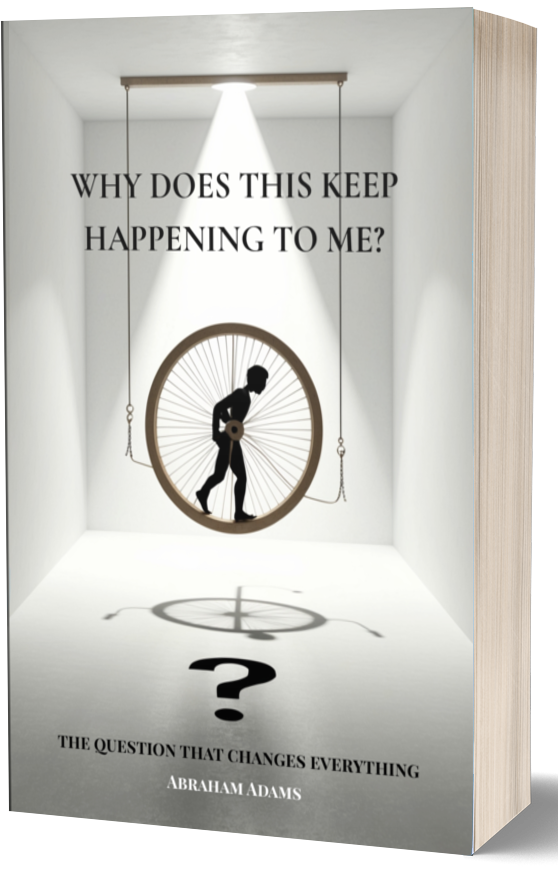
The Question That Changes Everything
You set your alarm fifteen minutes earlier, determined to finally have a peaceful morning. For three days, it works. Then you're back to hitting snooze, rushing through your routine, and starting each day feeling behind. Again.
You promise yourself you'll eat healthier. You buy all the right foods, meal prep on Sunday, and feel motivated. By Wednesday, you're back to grabbing fast food on the way home from work. Again.
You have a long conversation with your partner about communication, both of you committed to being more patient and understanding. Within a week, you're having the same argument you've had dozens of times before. Again.
If you're reading this, you've probably asked yourself the question that inspired this book's title: "Why does this keep happening to me?"
You're not alone. We all have patterns in our lives that repeat despite our best efforts to change them. We try harder, set better goals, read more self-help books, and promise ourselves we'll be different this time. Sometimes we succeed temporarily, but often we find ourselves right back where we started.
Here's what most people don't realize: the problem isn't your willpower, your motivation, or your character. The problem is that you're trying to fix the wrong thing.
When Sarah kept failing to wake up earlier, she bought seven different alarm clocks. What she didn't realize was that her evening glass of wine was disrupting her sleep, which made her groggy in the morning, which made her hit snooze, which made her day stressful, which made her want wine in the evening to relax. The alarm clock was never the problem.
When Mark and his wife kept fighting about money, they tried budgeting apps, spending trackers, and financial counseling. What they didn't realize was that Mark felt unappreciated at work, which made him want to buy things to feel better, which created financial stress, which made him defensive when she brought up spending, which led to fights that made him feel even more unappreciated. The budget was never the problem.
The real problem was that Sarah and Mark were looking at single events instead of seeing the connections between them. They were trying to fix individual pieces instead of understanding how those pieces fit together.
This book will show you how to see those connections in your own life. You'll learn to recognize the hidden patterns that keep you stuck, and more importantly, you'll discover where to make changes that actually stick.
You don't need more willpower. You don't need to try harder. You just need to understand what's really happening.
The answer starts with one simple question, and it will change everything.
Let's begin. Click Here to Order From Amazon
Building Your Radar System
Developing Your Assumption Radar: When to Question What You Know
You can't examine every belief you hold – you'd never leave the house. But you can learn to recognize the moments when your assumptions might be leading you astray. Think of it as developing an internal radar system that pings when it's time to question what you're taking for granted.
Just like a smoke detector doesn't go off for every tiny wisp of steam from your morning shower, your assumption radar doesn't need to be hypersensitive. It just needs to alert you to the moments when hidden beliefs might be causing real problems.
The Wall You Keep Hitting
Jessica has been trying to grow her consulting business for two years. She's improved her website, updated her LinkedIn profile, and attended countless networking events. But her client base remains frustratingly small.
One day, a colleague suggests she raise her prices.
"I can't do that," Jessica responds immediately. "My clients are small businesses. They don't have big budgets."
"Have you asked them what they can afford?"
Jessica pauses. She hasn't. She's been setting her rates based on what she assumes small businesses can pay, not on what they've actually told her they can pay.
This is the classic "hitting the same wall" scenario. When you keep trying different tactics but getting the same results, your assumption radar should start beeping. The problem isn't your execution – it's likely something you believe to be true that might not be.
When you notice this pattern, ask yourself: "What am I taking for granted about this situation?" Often, you'll discover you've been solving the wrong problem entirely.
That Nagging Feeling
Have you ever felt stuck but couldn't explain why? You know something's not right, but you can't put your finger on what it is. That restless, frustrated feeling is often your intuition bumping up against a hidden assumption.
Tom felt this way about his job. On paper, everything looked good – decent salary, nice colleagues, reasonable hours. But he dreaded Monday mornings and felt increasingly disconnected from his work.
When friends asked what was wrong, he'd say, "Nothing really. I should be grateful." But that word "should" was a clue. Tom was operating on the assumption that a good job meant you had to be happy with it, and if you weren't, something was wrong with you.
It took months before Tom realized he was assuming he had to choose between security and fulfillment. What if he could have both? What if feeling bored at work wasn't a character flaw but a signal that he'd outgrown his role?
When you feel stuck without a clear reason, your assumption radar should activate. That vague dissatisfaction often means you're bumping against invisible limits you've placed on yourself.
The Instant "No Way" Reaction
Your assumption radar should definitely go off when someone suggests something and your immediate reaction is strong and negative.
Lisa runs a small bakery and has been struggling with weekend staffing. When her friend suggests hiring college students for weekend shifts, Lisa immediately responds, "College kids aren't reliable. They'll call in sick or just not show up."
"Have you tried hiring any?"
"No, but I know what they're like."
Lisa's instant reaction revealed an assumption about an entire group of people based on... what exactly? Stories she'd heard? Her own behavior in college decades ago? One bad experience with a teenage employee years ago?
When you find yourself immediately dismissing an idea, pause and ask: "What belief just got triggered?" Often, that strong reaction is protecting an assumption that might not be true anymore – or might never have been true in the first place.
The "Because" Trap
Listen to yourself over the next week and count how many times you say "I can't because..." The word "because" often introduces an assumption disguised as a fact.
"I can't start my own business because I don't have enough savings."
How much is enough? Have you researched what it actually costs to start your specific type of business? Are there ways to start smaller than you imagined?
"I can't ask for a promotion because they just hired someone new."
How do you know the new hire affects your promotion prospects? Have you asked?
"I can't move to a new city because I don't know anyone there."
Is knowing people a requirement for moving, or is it just something that would make it easier?
Your assumption radar should ping every time you hear yourself using "I can't because" followed by something you haven't actually verified.
The Big Decision Warning
Before any major decision – changing jobs, ending relationships, making large purchases, moving cities – your assumption radar should be on high alert.
Marcus was offered a job in another city but immediately started listing reasons why he couldn't take it: "The cost of living is too high, I don't know anyone there, and it's too far from family."
But when his wife asked him to research actual housing costs, he discovered they were only slightly higher than his current city. When he thought about it, he realized he'd built friendships before and could do it again. And "too far from family" meant a four-hour drive instead of one hour – not exactly moving to another continent.
Marcus almost turned down a great opportunity because he accepted his initial assumptions as facts instead of treating them as questions worth investigating.
Before big decisions, ask yourself: "What am I assuming about this situation that I haven't actually verified?"
The Always and Never Alarm
Your assumption radar should immediately activate when you hear yourself using absolute words like "always," "never," "everyone," or "no one."
"Customers always choose the cheapest option."
Really? Always? What about Apple customers who pay premium prices for design? What about people who shop at Whole Foods instead of Walmart?
"My boss never listens to new ideas."
Never? Has he rejected every single suggestion ever made? Or just the ones you've made? Or maybe just the ones that weren't presented in the way he prefers to receive information?
"Nobody wants to pay for quality anymore."
Nobody? What about the craftspeople selling handmade goods on Etsy? The restaurants that charge premium prices for farm-to-table ingredients? The consumers who research products extensively before buying?
Absolute statements are almost always based on limited experience treated as universal truth. When you catch yourself using these words, ask: "Is this actually always true, or just true in my experience?"
The Other People Problem
Your assumption radar should also activate during interpersonal conflicts. Often, frustration with others reveals assumptions about how things "should" work.
Katie was constantly annoyed with her coworker Jake, who never responded to emails immediately. She assumed Jake was being disrespectful or lazy.
One day, she discovered that Jake batches his email responses to avoid constant interruption from his project work. He wasn't being rude – he was being efficient. Katie had assumed that immediate email responses were a sign of professionalism, but Jake assumed that focused work time was more professional.
When you're frustrated with someone's behavior, ask: "What assumption am I making about why they're acting this way?" Often, people aren't trying to annoy you – they're operating from different beliefs about what's appropriate or effective.
Building Your Radar System
Developing assumption radar isn't about becoming paranoid or questioning everything. It's about recognizing specific moments when hidden beliefs might be limiting your options.
Here are the key signals to watch for:
- You keep getting the same unwanted results despite changing tactics
- You feel stuck but can't articulate why
- Someone's suggestion triggers an immediate negative reaction
- You find yourself saying "I can't because..." followed by something unverified
- You're about to make a big decision
- You use absolute language like "always" or "never"
- You're frustrated with other people's behavior
The Power of the Pause
When your assumption radar goes off, you don't need to immediately overturn all your beliefs. Often, it's enough to simply pause and ask: "What am I taking for granted here?"
Sometimes you'll discover your assumption is worth keeping. Maybe those college students really wouldn't be reliable for your specific business. Maybe your boss genuinely doesn't listen to new ideas. Maybe the cost of living really is too high in that other city.
But sometimes – often – you'll discover that what you thought was a fact was actually just a belief. And beliefs, unlike facts, can be changed.
Making Space for Possibility
The goal of assumption radar isn't to make you doubt everything. It's to help you recognize when you might be operating with outdated or incomplete information.
When Jessica questioned her pricing assumptions, she discovered that several clients had been hoping she'd offer higher-level services at higher prices. When Tom questioned his assumption about security versus fulfillment, he found a role that offered both. When Marcus questioned his assumptions about the job offer, he realized the opportunity was better than he'd initially thought.
Your assumption radar is simply a tool for creating space between automatic reactions and conscious decisions. It's the difference between being run by your beliefs and choosing your beliefs.
What assumptions might be operating quietly in your life right now? Your radar is already equipped to help you find them – you just need to start listening for the signals.
The Invisible Rules Running Your Life
The Invisible Rules Running Your Life
Imagine you're driving to work, taking the same route you've taken for years. You turn left at the familiar intersection, merge onto the highway at your usual spot, and arrive at your destination without thinking twice. But what if I told you that construction started yesterday and there's now a faster route? You'd never know because you stopped looking for alternatives long ago.
This is how assumptions work in our lives. They're the invisible rules we follow without questioning, the mental shortcuts that help us navigate daily life, but sometimes keep us stuck in patterns that no longer serve us.
What Are Assumptions Really?
An assumption is simply something you believe to be true without checking. Right now, you're assuming the chair you're sitting in will hold your weight. You're assuming your paycheck will arrive on schedule. You're assuming your spouse still loves you because they made you coffee this morning.
Most of the time, assumptions are helpful. They let us function without constantly second-guessing everything. Imagine if you had to verify every single belief before acting on it – you'd never get out of bed.
But here's where it gets interesting: we make assumptions about much bigger things too, often without realizing it.
The Stories We Tell Ourselves
Sarah works at a marketing firm and desperately wants a promotion, but she's never asked for one. When her friend suggests she talk to her boss, Sarah immediately responds, "Oh, they don't have the budget for promotions right now."
Her friend asks, "How do you know that?"
Sarah pauses. "Well, they haven't given anyone a promotion in months."
"Have you asked?"
"No, but I can tell they're being careful with money."
Sarah has built an entire story about her company's financial situation without a single conversation with her boss. Her assumption – that promotions aren't available – has become a prison that keeps her from even trying.
We all do this. We create elaborate explanations for why things are the way they are, then treat those explanations as facts.
The Assumption Trap
Here's the tricky part about assumptions: they're self-reinforcing. Once you believe something, you unconsciously look for evidence that supports it and ignore evidence that contradicts it.
Take Mark, who believes he's "not good with technology." Every time he struggles with a new app or device, he thinks, "See? I told you I'm hopeless with this stuff." But when he successfully uses technology – which happens dozens of times each day – he doesn't notice. His phone works, his car starts, his coffee maker brews his morning cup. But these successes don't register because they don't fit his story about himself.
This is why assumptions can be so limiting. They don't just describe reality – they shape it.
The Hidden Assumptions About Success
Let's dig into some common assumptions that might be running in the background of your thinking:
"Hard work always pays off." This sounds noble, but what if you're working hard on the wrong things? What if you're pouring energy into a strategy that stopped working years ago?
"Good work speaks for itself." Many talented people assume that if they just do excellent work, recognition will naturally follow. But in most organizations, visibility and communication matter just as much as competence.
"I need more education before I can make a career change." This assumption keeps countless people stuck in jobs they've outgrown. Sometimes experience and willingness to learn matter more than formal credentials.
"People like me don't start businesses." This assumption is often based on background, age, location, or past experience. But what if that's not true? What if the very thing that makes you different is exactly what the market needs?
Where Assumptions Come From
Our assumptions aren't random. They come from somewhere specific:
Past experience: If you were rejected the last three times you applied for a promotion, you might assume all future attempts will fail too.
Other people's opinions: Maybe your high school guidance counselor told you that you weren't "college material," and you've carried that belief for decades.
Cultural messages: We absorb countless assumptions from our families, communities, and society about what's possible, appropriate, or realistic for people like us.
Fear dressed up as wisdom: Sometimes we create assumptions to protect ourselves from disappointment. "I probably wouldn't get the job anyway" feels safer than risking rejection.
The problem is that these assumptions, once formed, become invisible. They sink into the background and influence every decision without us noticing.
The Cost of Unexamined Assumptions
When we don't question our assumptions, we miss opportunities, limit our potential, and sometimes make decisions based on information that's years out of date.
Consider the assumption many people have about failure: "If I fail, it means I'm not good enough." This single belief keeps people from trying new things, starting businesses, asking for dates, or pursuing dreams. But what if failure just means you're learning? What if it means you're pushing boundaries and growing?
Or take the assumption about age: "I'm too old to start over." Says who? Colonel Sanders was 62 when he franchised KFC. Vera Wang was 40 when she entered fashion. Laura Ingalls Wilder didn't publish her first Little House book until she was 64.
How to Spot Your Own Assumptions
The tricky thing about assumptions is that they're invisible to the person holding them. Here are some clues that you might be operating on unexamined beliefs:
Listen for absolute language: When you hear yourself saying "always," "never," "everyone," or "no one," there's probably an assumption lurking nearby.
Notice your "of course" moments: When something seems obviously true to you but others question it, that's worth examining.
Pay attention to strong emotional reactions: If someone's suggestion makes you immediately angry or defensive, ask yourself what belief they might be challenging.
Look for patterns: If you keep getting the same unsatisfying results despite changing your tactics, you might need to question your strategy entirely.
The Art of Gentle Questioning
You don't need to tear down all your assumptions overnight. In fact, doing so would be exhausting and probably counterproductive. Instead, try gentle curiosity:
"What would need to be true for this to work?"
"How do I know this is always the case?"
"What if the opposite were possible?"
"Where did this belief come from originally?"
"What would I try if I knew I couldn't fail?"
These questions aren't about proving yourself wrong – they're about opening up new possibilities you might not have considered.
The Liberation of Maybe
Here's something powerful: you don't have to completely abandon an assumption to benefit from questioning it. Sometimes it's enough to add the word "maybe" to your beliefs.
Instead of "I'm not creative," try "Maybe I haven't found the right outlet for my creativity yet."
Instead of "This company doesn't value innovation," try "Maybe they haven't seen the right kind of innovation proposal yet."
Instead of "I'm too old to learn new skills," try "Maybe I just need to find the right approach to learning."
That simple word – maybe – creates space for new possibilities without requiring you to completely overturn your worldview.
Your Assumptions, Your Choice
The goal isn't to eliminate all assumptions – that's impossible and unnecessary. The goal is to become aware of the ones that matter most and consciously choose which ones serve you.
Some assumptions are worth keeping. The assumption that people generally mean well helps you build relationships. The assumption that hard work matters gives you motivation to persist through challenges.
But other assumptions might be holding you back from the life you actually want to live.
The beautiful thing about assumptions is that once you see them clearly, you realize they're choices, not facts. And if they're choices, you can make different ones.
What assumptions might be running quietly in the background of your life right now? What would become possible if you questioned just one of them?
The answers might surprise you.
Part 10: Integration & Mastery - Your Personal Systems Approach
Part 10: Integration & Mastery - Your Personal Systems Approach
You've learned to see your mind as a system. You've discovered how thoughts, emotions, and behaviors connect in circular patterns. You've explored how your environment shapes your thinking. You've experienced the power of small changes creating ripple effects. You've developed tools for when systems get stuck and practices for long-term maintenance.
Now comes the most important part: weaving all of this together into your own unique approach to working with your mental system. This isn't about following someone else's formula or trying to implement every technique perfectly. It's about developing your personal mastery – a way of being with your mind that feels natural, sustainable, and aligned with who you are and who you're becoming.
True mastery in systems thinking isn't about having perfect control over your mental patterns. It's about developing such a fluid, responsive relationship with your mental system that working with it becomes as natural as breathing. You stop fighting against your mind and start dancing with it.
Think about a master musician. They've learned scales, techniques, and theory, but when they perform, they're not consciously thinking about finger positions or music theory. All of that knowledge has integrated into an intuitive flow where technique serves expression rather than constraining it. The musician and the music become one seamless system.
Your relationship with your mental system can develop the same kind of integrated fluidity. The concepts and techniques you've learned become background wisdom that informs your responses without requiring conscious effort. You develop an intuitive sense of what your system needs and how to provide it.
This integration happens gradually through what we might call conscious practice – deliberately applying systems thinking in your daily life until it becomes second nature. But integration isn't just about repetition. It's about discovering your unique patterns, preferences, and leverage points.
Your mental system is as individual as your fingerprint. The patterns that create stress for one person might be energizing for another. The environments that support one person's creativity might stifle someone else's. The maintenance practices that work beautifully for your friend might feel forced or ineffective for you.
Developing mastery means becoming an expert on your own system – understanding its quirks, tendencies, and optimal conditions better than anyone else possibly could. This expertise comes not from analyzing yourself to death, but from patient, curious observation over time.
Start by identifying your personal patterns across different areas of life. What are your natural energy rhythms throughout the day, week, and year? When do you typically feel most creative, focused, or emotionally balanced? What environments naturally support your best thinking? What kinds of challenges energize you versus drain you?
Notice your unique stress signatures – the early warning signs that tell you when your system is getting overwhelmed or unbalanced. Some people feel stress first in their body as tension or fatigue. Others notice it in their thinking as mental fog or racing thoughts. Still others recognize it through changes in sleep, appetite, or social energy.
Understanding your personal stress signals allows you to intervene early with the specific approaches that work best for your system. Maybe you need movement when you're getting overwhelmed. Maybe you need quiet time alone. Maybe you need to talk through challenges with others. Maybe you need to change your environment or adjust your schedule.
Discover your leverage points – the small changes that create the biggest positive shifts in your unique system. These are often surprising and highly individual. For some people, the most powerful leverage point is their morning routine. For others, it's their social connections, physical exercise, creative expression, or information diet.
Your leverage points might be completely different from what works for others, and that's exactly as it should be. The goal is finding what works for your system, not what theoretically should work or what works for other people.
Experiment with different approaches and pay attention to what creates sustainable positive change versus what creates temporary improvement that fades quickly. Sustainable changes usually feel natural and energizing rather than forced and effortful. They align with your existing patterns rather than fighting against them.
As you develop this self-knowledge, you'll start to see how all the different elements of your mental system work together. Your sleep affects your emotional resilience, which influences your social interactions, which impact your self-perception, which shapes your decision-making, which affects your stress levels, which influence your sleep. Everything connects to everything else in your unique constellation of patterns.
This interconnected understanding allows you to work with your system strategically rather than randomly. Instead of trying to improve everything at once, you can focus your energy on the changes that will naturally support positive shifts throughout your entire system.
Integration also means developing what we might call systems intuition – the ability to sense what your mental system needs in any given moment without having to think through all the theory and techniques. This intuition develops through practice and attention.
You might walk into a situation and intuitively sense that your system needs grounding, so you automatically adjust your breathing or posture. You might notice a thought pattern starting and naturally redirect your attention before it becomes a stuck loop. You might feel your energy shifting and spontaneously choose activities that restore your balance.
This isn't magic – it's the natural result of becoming deeply familiar with your system's rhythms and responses. Like a gardener who can tell by looking at a plant exactly what it needs, you develop the ability to read your mental system's needs accurately and respond appropriately.
Mastery also involves developing resilience – not the kind that powers through everything, but the flexible kind that adapts skillfully to whatever arises. This means having multiple tools and approaches available so you're not dependent on any single strategy.
Some days meditation might be exactly what your system needs. Other days, meditation might feel like the wrong approach, and you might need movement, social connection, creative expression, or simply rest. Resilient systems have options and can shift approaches based on current conditions rather than rigidly applying the same solution to every situation.
This flexibility extends to how you think about progress and setbacks. Instead of seeing challenges as failures or signs that you're doing something wrong, you learn to read them as information about what your system needs. A difficult period might signal that you need to adjust your practices, change your environment, seek additional support, or simply allow time for natural adaptation.
Mastery means becoming comfortable with the dynamic, ever-changing nature of mental systems. You stop trying to achieve a perfect state and instead learn to skillfully navigate the natural fluctuations of mental life. You develop confidence in your ability to work with whatever arises rather than needing everything to be smooth and predictable.
One of the most sophisticated aspects of integration is learning to work with paradox. Your mental system often requires seemingly contradictory approaches simultaneously. You might need to be both disciplined and flexible, both focused and open, both accepting and change-oriented.
Instead of seeing these as problems to be resolved, you learn to hold them as creative tensions that generate growth and possibility. You become comfortable with not having everything figured out while still taking thoughtful action. You develop the ability to be fully present with what is while simultaneously working toward what could be.
Integration also means recognizing that your approach will continue evolving throughout your life. The strategies that serve you in your twenties might need adjustment in your forties. The patterns that work during stable periods might need modification during times of transition. The practices that support you in one season of life might feel stale or inappropriate in another.
This evolution isn't a problem to be solved but a natural characteristic of living systems. Staying curious about your changing needs and remaining open to adjusting your approach keeps your relationship with your mental system alive and responsive rather than rigid and mechanical.
As you develop integration and mastery, you'll likely find that your approach becomes increasingly simple and elegant. Instead of needing complex systems and elaborate practices, you develop a few core principles and practices that serve you reliably across many different situations.
This simplicity isn't simplistic – it's the refined simplicity that comes from deep understanding. Like a master chef who can create extraordinary meals with basic ingredients and simple techniques, you learn to work with your mental system using fundamental principles applied with skill and sensitivity.
Perhaps most importantly, integration means developing compassion for your mental system and all its quirks, patterns, and imperfections. You stop seeing your mind as an adversary to be controlled and start relating to it as a partner to be understood and supported.
This compassionate relationship becomes the foundation for sustainable transformation. When you approach your mental patterns with curiosity rather than judgment, acceptance rather than force, and patience rather than urgency, your system naturally moves toward greater health and alignment.
You realize that you don't have to be perfect, have everything figured out, or never struggle with mental challenges. You simply need to maintain a caring, attentive relationship with your own consciousness and trust in your system's natural intelligence and tendency toward growth.
The journey of developing your personal systems approach is ongoing and endlessly fascinating. There's always more to discover about how your unique mind works, new patterns to explore, and deeper levels of integration to develop.
But you now have the foundation for this lifelong exploration. You understand your mind as a system, you have tools for working with that system skillfully, and you're developing the wisdom to apply those tools in ways that serve your unique patterns and aspirations.
This is true mastery – not perfect control, but skillful partnership. Not rigid adherence to techniques, but flexible responsiveness to what each moment requires. Not fighting against your mental patterns, but dancing with them in increasingly graceful and effective ways.
Your mind is perhaps the most sophisticated system you'll ever have the privilege to work with. Treat it with the respect, curiosity, and care it deserves. Trust in its remarkable capacity for growth and transformation. And remember that every moment offers a new opportunity to deepen your understanding and refine your approach.
The art of systems thinking applied to thought is ultimately the art of conscious living – being fully present to your mental experience while skillfully shaping it in alignment with your deepest values and highest aspirations. This is both the simplest and most profound work you can do.
Welcome to mastery. The journey continues.
- Audio Articles
- Audio Articles 1
- Audio Articles 2
- Audio Articles 3
- Audio Articles 4

7 Daily Disciplines That Transform Your Life
The power to act with intention, to align your actions with your values, and to move steadily toward a life of purpose—even on days you don't feel like it.
Read Full Article
How to Build Unbreakable Discipline
Discipline is built—habit by habit, choice by choice, day by day. And the most powerful kind? The kind that doesn’t crack under pressure. The kind that becomes part of who you are.
Read Full Article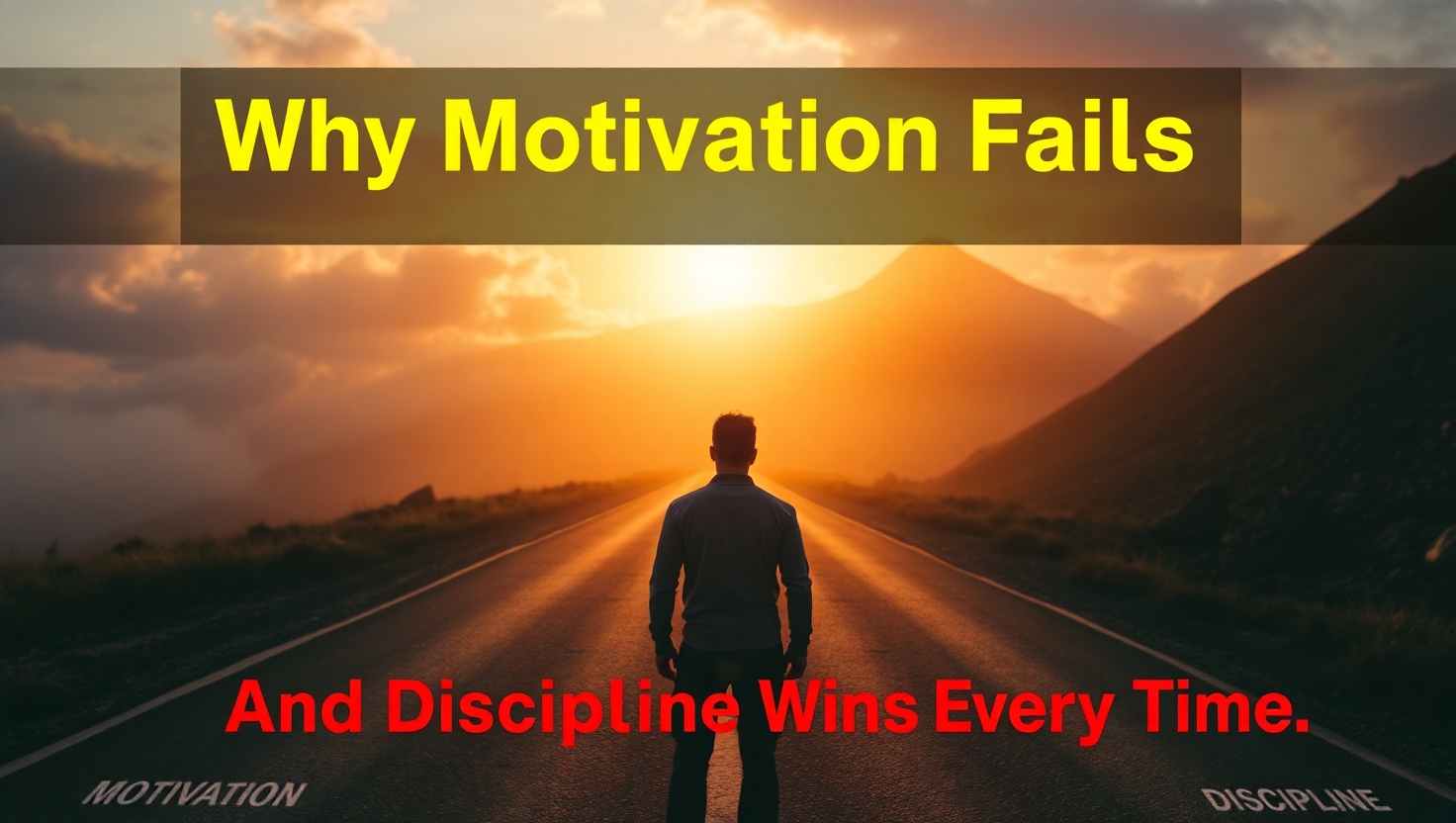
Why Motivation Fails And Discipline Wins Every Time
We all love the feeling of motivation—that surge of energy, that rush of inspiration that makes everything seem possible. But here’s the problem: motivation is unreliable. It’s emotional. It comes and goes. And if your goals rely on you “feeling like it,” you’re already in trouble.
Read Full Article
Discipline Over Desire
Desire is loud. It burns bright, talks fast, and loves to dream. But desire alone doesn't achieve much. Every person has desires. Very few have the discipline to bring them to life.
Read Full Article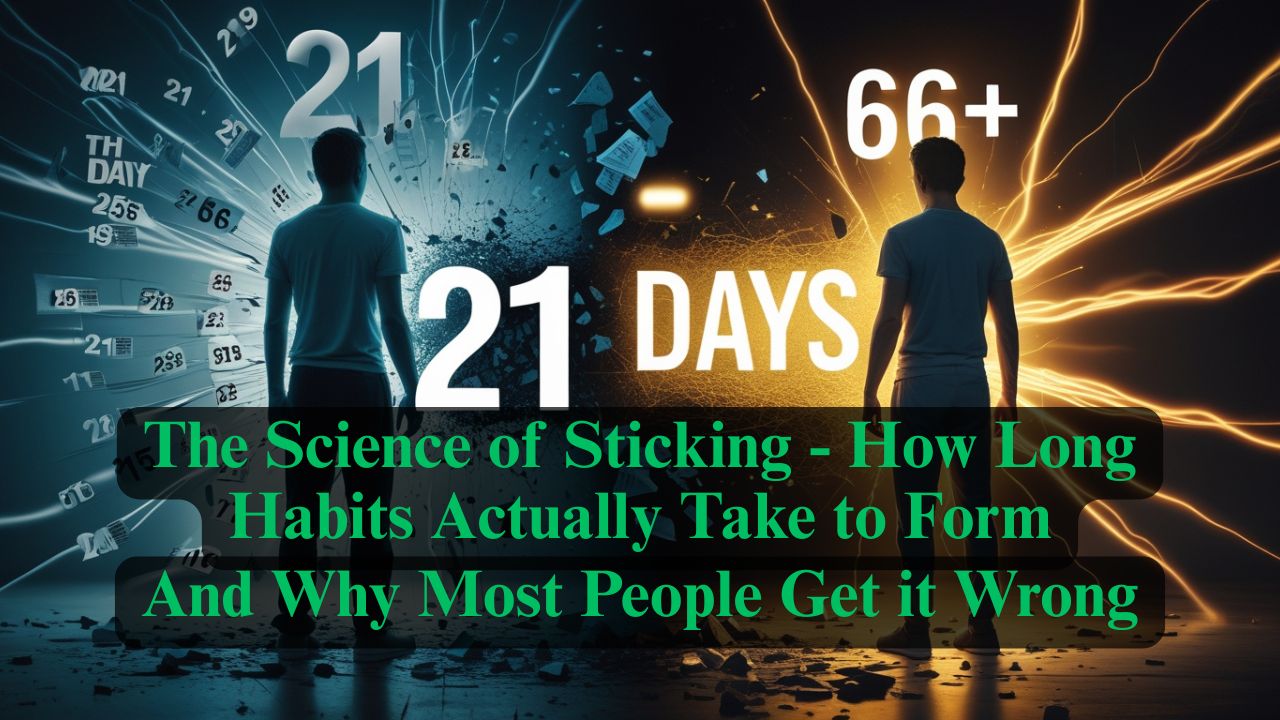
The Science of Sticking
If you've ever tried to build a new habit, you've probably heard that it takes 21 days. This number gets thrown around so often that it feels like scientific fact.
Read Full Article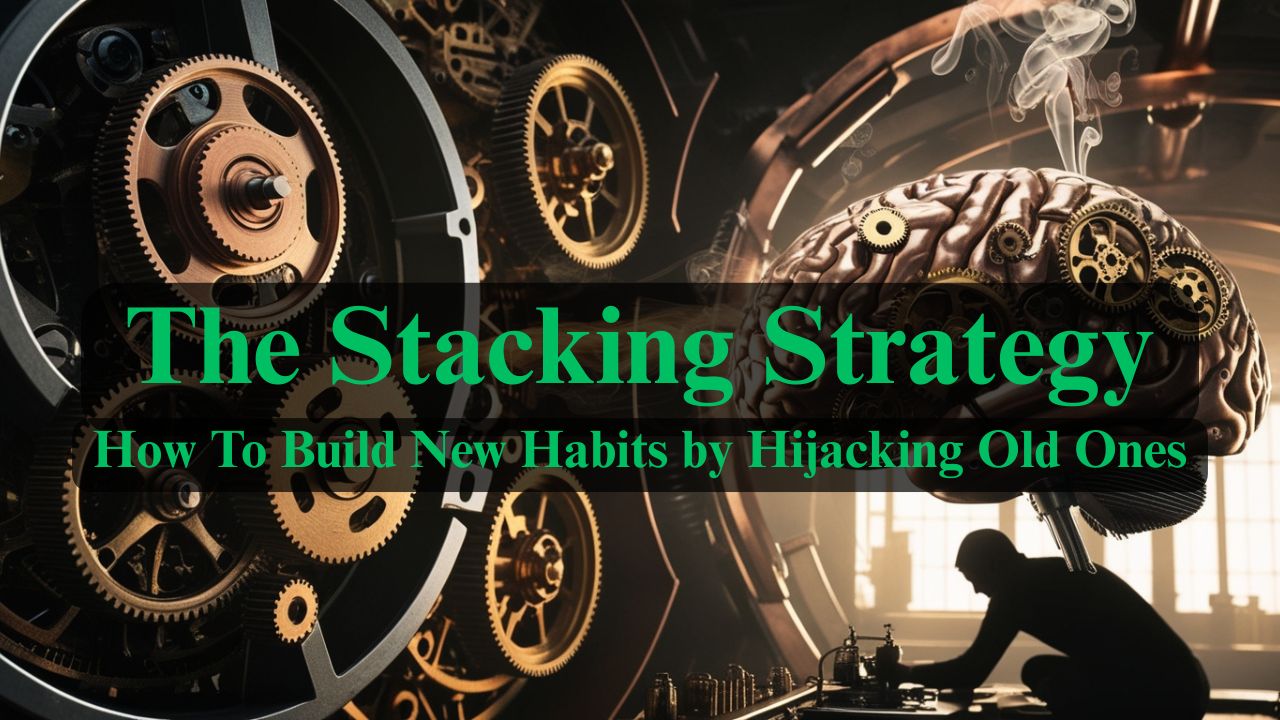
The Stacking Strategy
What if I told you that the habits you already have—even the ones you consider "bad"—could become the secret weapons for building the habits you want?
Read Full Article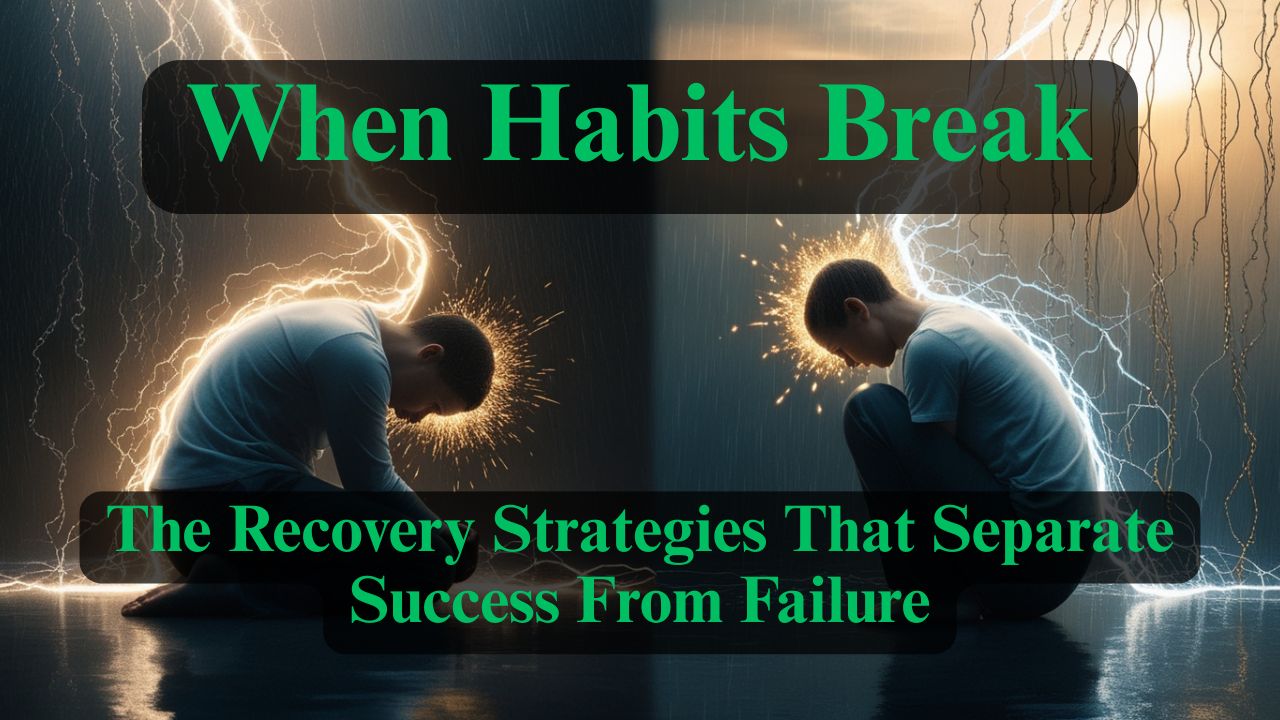
When Habits Fail - The Recovery Strategies That Separate Success From Failure
Here's what nobody tells you about building habits: you will fail. You'll miss days. You'll fall off track. You'll have weeks where everything falls apart.
Read Full Article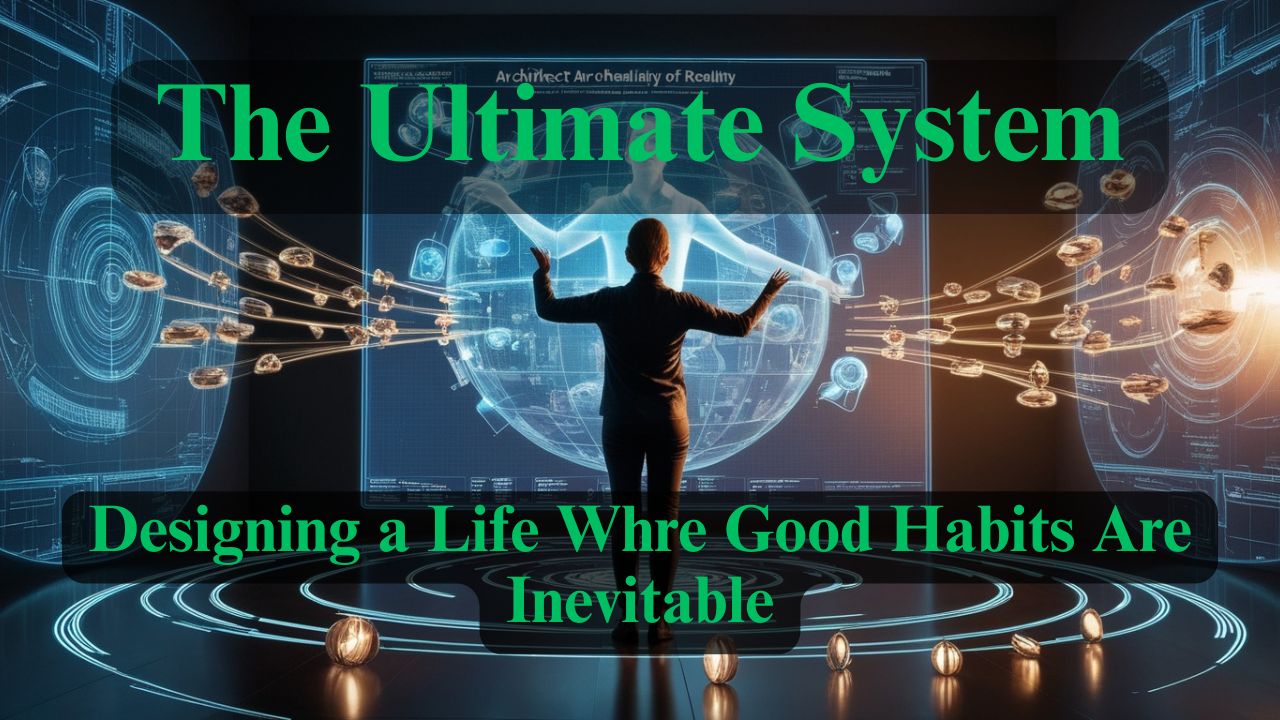
The Ultimate System - Designing a Life Where Good Habits Are Inevitable
You've learned to recognize habits, understand their formation timeline, stack them strategically, and recover from setbacks.
Read Full Article






